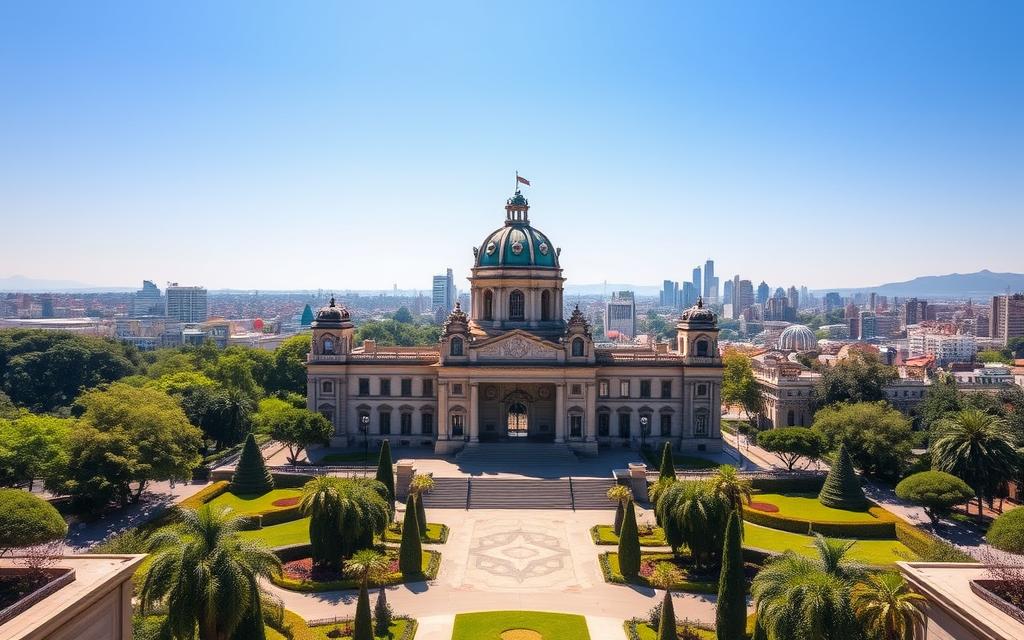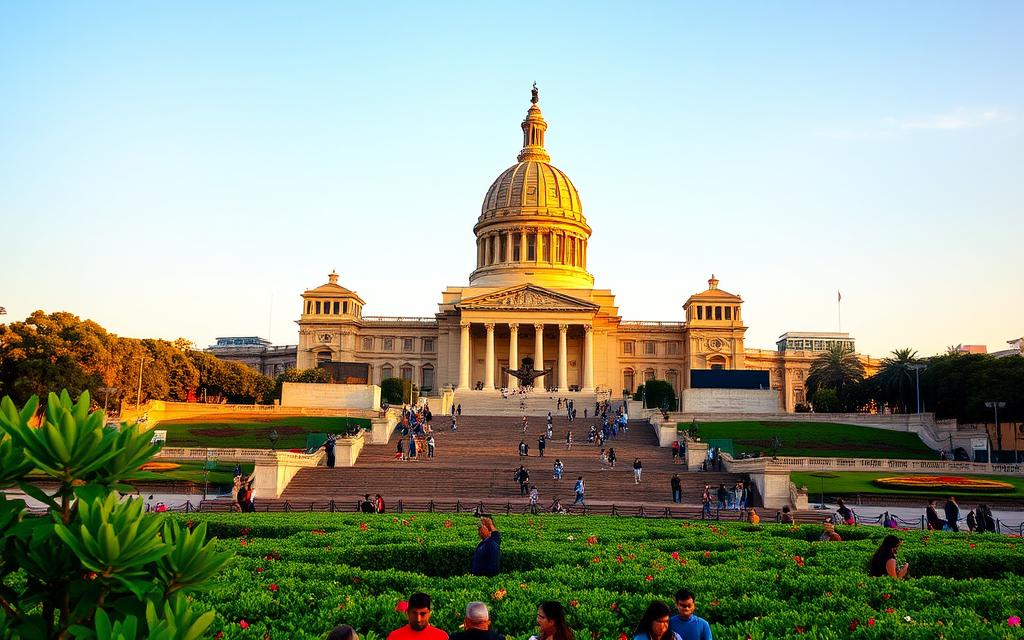Visiting landmarks in Mexico is a breathtaking and history-filled adventure that world travelers and heritage explorers shouldn’t miss. Imagine standing before the towering, ancient pyramids of Chichen Itza. Marvel at the intricate stone structures that have amazed visitors for centuries. Or picture yourself walking through Mexico City’s vibrant, historic streets. You’re surrounded by stunning colonial architecture and lively markets.
Mexico is more than beautiful beaches, great weather, and tasty food. It’s a country filled with cultural heritage and remarkable landmarks.
This article will take you on a journey through Mexico’s most iconic landmarks and natural wonders. You’ll learn the stories and significance of these awe-inspiring sites. From Tulum’s ancient Mayan ruins to Teotihuacan’s towering Pyramid of the Sun, you’ll discover their fascinating history and cultural importance.
So, are you ready to explore Mexico’s hidden gems and architectural marvels? This country is a unique and captivating travel destination.
Key Takeaways
- Mexico boasts an abundance of historical landmarks and cultural treasures that go beyond its renowned beaches and cuisine.
- Iconic sites like Chichen Itza, Teotihuacan, and the National Museum of Anthropology showcase Mexico’s rich history and indigenous heritage.
- Exploring Mexico’s landmarks offers a deeper appreciation for the country’s architectural wonders, ancient civilizations, and diverse cultural traditions.
- From UNESCO World Heritage Sites to hidden natural gems, Mexico’s landmarks provide a unique and immersive travel experience.
- Embarking on a heritage-focused trip to Mexico allows travelers to gain a richer understanding of the country’s past and present.
The Benefits of Heritage Travel
Traveling through Mexico’s rich cultural heritage lets you connect with the country’s past. You can understand its vibrant traditions better. By visiting historical landmarks and archaeological sites, you dive into the legacy of the Maya, Zapotec, and other indigenous civilizations.
Landmarks In Mexico Are Perfect for Heritage Trips
Top heritage spots in Mexico include Chichen Itza, Monte Alban, and Tulum ruins. These places show off the ancient cultures’ architectural and engineering skills. They also make visitors think about their own roots and identity.
Heritage travel in Mexico helps you appreciate the country’s people, customs, and way of life. It also helps preserve and conserve these cultural treasures.
Unveiling Mexico’s Ancient Marvels
Mexico is filled with a deep and fascinating history. It has many ancient ruins and sites that show its pre-Hispanic past. Two of the most famous and amazing sites are Chichen Itza and Monte Alban.
Chichen Itza: The New Seven Wonders of the World
Chichen Itza is a huge Mayan city on the Yucatan peninsula. It’s one of the New Seven Wonders of the World. This site shows the Maya’s engineering skills and culture, with temples, plazas, and ball courts.
Visitors can explore the famous chichen itza pyramid. They can see the detailed carvings and structures. It’s a way to connect with the Maya’s rich history and legacy.
Monte Alban: A Zapotec Archaeological Site
Monte Alban is in the hills of Oaxaca. It’s a key Zapotec archaeological site. It has pyramids, temples, and an acropolis over 2,500 years old.
Walking through the monte alban ruins, visitors dive into the Zapotec’s history and culture. It’s a chance to see the achievements of one of Mesoamerica’s most important civilizations.
Exploring these ancient sites in Mexico lets travelers discover the country’s past. They can connect with the indigenous peoples and their amazing achievements.
Towering Pyramids and Ruins
Mexico boasts some of the world’s most impressive structures, including towering pyramids. The great pyramid of cholula in Puebla is the largest pyramid in the world by volume. For centuries, it was hidden under earth and vegetation, mistaken for a natural hill.
Excavations uncovered its secrets, revealing tunnels, altars, and more. These discoveries show the engineering skills of Mesoamerican civilizations. They built it over 2,000 years ago.
The Great Pyramid of Cholula: A Hidden Giant
The great pyramid of cholula is massive, covering 450 by 450 meters at its base. It’s even bigger than Egypt’s famous pyramids. For centuries, it was buried, blending into the landscape.
Now, visitors can explore its tunnels and uncover its secrets. It offers a unique look into Mexico’s cultural heritage.
Coastal Treasures: Tulum Ruins
The Tulum ruins sit on Mexico’s Quintana Roo state’s Caribbean coast. They are a well-preserved Mayan site on a cliff. This walled port city shows the Maya’s seafaring culture and strategic spots.
Visiting the tulum ruins feels like stepping back in time. You can explore ancient ruins and dive into the Maya’s history. It’s just a 2-hour drive from Cancun airport. The ruins mix Mexico’s heritage with its natural beauty.
For 90 pesos, you can enter the Tulum ruins any time of the year. They are open from 8am to 5pm. Renting a car for $245 for 10 days lets you explore the Tulum area fully.
Mexico City’s Cultural Gems
Exploring Mexico’s culture is best done in its capital, Mexico City. The Museo Nacional de Antropología is a key spot. It’s a treasure trove for learning about Mexico’s indigenous cultures and history.
Museo Nacional de Antropología: A Window into Mexico’s Past
This museum is a stunning example of architecture. It has a vast collection of artifacts. You can see Aztec headdresses and a massive sculpture of a fire serpent deity.
The exhibits take you back in time. They show the many pre-Hispanic civilizations that shaped Mexico’s culture.
The Zocalo: A Bustling Heart of History
The Zocalo is right next to the museum. It’s Mexico City’s main square. Here, you’ll find the Catedral Metropolitana and National Palace, both National Monuments.
Walking around these places is like stepping into Mexico’s history. It’s where the old and new meet in a vibrant way.
Castillo de Chapultepec: A Regal Residence
The Castillo de Chapultepec stands tall over Mexico City from Chapultepec Hill. It was once a royal home and now a national museum. This 18th century castle has been a presidential palace and a military school. Today, it amazes visitors with its gold decorations, murals, and statues.
This UNESCO World Heritage Site is 67 meters (220 feet) high and sits at 2,325 meters (7,628 feet) above sea level. Its construction started around 1785 and finished in 1864. Many architects worked on its design.
The museum has 12 galleries filled with artifacts from Mexico’s history. These include the War of Independence to the Mexican Revolution. It’s a key place to see for those interested in Mexico City landmarks and national museums in Mexico.
Landmarks in Mexico: Underwater Wonders
Mexico is famous for its amazing above-ground landmarks. But it also has incredible underwater wonders. The Museo Subacuático de Arte (MUSA) is a standout. It’s the world’s largest underwater museum, found near Cancun and Isla Mujeres.
Museo Subacuático de Arte: An Underwater Sculpture Park
This attraction has over 500 life-size sculptures by British artist Jason deCaires Taylor. They’re submerged to make an underwater art gallery. It’s not just beautiful; it also helps the environment.
The sculptures help grow coral reefs and protect the Mesoamerican Reef. Visiting this unique place is a special experience. It’s a must-see for those interested in Mexico’s underwater landmarks and Cancun attractions.
Historic Landmarks in Mexico: Revolutionary Monuments
The Monumento a la Revolución in Mexico City honors Mexico’s fight for freedom. It took 28 years to finish, from 1910 to 1938. This grand arch is a tribute to the heroes of the Mexican Revolution.
It’s not just a monument. It also holds the remains of famous revolutionaries like Pancho Villa and Lázaro Cárdenas. This makes it a unique place of remembrance.
Monumento a la Revolución: A Tribute to Mexican Liberation
Visitors can climb to the top for stunning views of the Plaza de la República. It’s a symbol of Mexico’s freedom and a beautiful architectural wonder. The design mixes Art Deco with Mexican socialist realism.
The Monumento a la Revolución is among Mexico City’s 16 famous landmarks. It stands at 19°26′10″N 99°09′17″W. It’s a key spot for understanding Mexico’s history and its fight for justice.
Celebrity Landmarks in Mexico: Frida Kahlo’s Blue House
Art and culture lovers must see the Museo Frida Kahlo in Mexico City. Known as La Casa Azul, this blue house was Frida Kahlo’s home. It’s now a museum showing her life and art.
Here, you can see some of Kahlo’s famous paintings. You’ll also see her personal items and furniture. It’s a peek into her creative world.
The museum collects data from visitors. This includes their name, age, and more. They use this info to contact people and improve their services.
Visitors can ask to be removed from the database. They can also update their info. The museum keeps your data safe.
La Casa Azul is very popular, with 25,000 visitors a month. It’s closed on Mondays and some holidays. Photography is not allowed unless you buy a special pass.
Hidden Gems of Mexico
Mexico has more than just famous landmarks. It’s also home to many hidden spots that are worth visiting. Two of these are the stunning Copper Canyon and the ancient El Tajin ruins.
Copper Canyon: A Natural Wonder
The Copper Canyon lies in the Sierra Madre Occidental mountains. It’s a vast area of rugged ravines and lush jungle. Visitors can explore it by riding the Copper Canyon Railway.
This railway takes you through breathtaking landscapes. You’ll see towering cliffs and waterfalls along the way.
El Tajin: A Pre-Hispanic City
El Tajin is another hidden treasure in Mexico, found in Veracruz. It was a key city in Mesoamerica’s Classic era. Its well-preserved pyramids and temples show the country’s ancient history.
Visiting El Tajin feels like stepping back in time. You’ll see the grandeur of an ancient civilization.
Exploring the Copper Canyon and El Tajin offers a unique look at Mexico. These spots show the country’s natural beauty and rich history. By going off the beaten path, travelers can discover Mexico’s true essence.
Conclusion
Mexico’s landmarks and natural wonders are a captivating journey. They show the country’s rich culture and diverse landscapes. From Chichen Itza’s ancient Mayan ruins to Mexico City’s vibrant museums, this guide highlights must-see spots.
Travelers can dive into Mexico’s past and present. Whether you love history, art, or nature, Mexico has something for everyone. Its landmarks offer endless ways to explore this remarkable place.
Mexico is a vast country with over 132 million people. It covers 758,449 square miles. The Sierra Madre Oriental and Sierra Madre Occidental mountains stand tall. Mexico’s cities buzz with life, while its wilderness is untouched.
Planning a trip to Mexico? This guide is your key to the top landmarks. Explore ancient ruins, stunning coastlines, and vibrant cities. Mexico will leave you with unforgettable memories.
Want to explore more heritage destinations? Here are a two that will capitvate!
Japan’s Landmarks: Places to Consider for Your Heritage Trip
Irish Landmarks: Background and Tips for a Unique Heritage Trip
FAQ
What are some of the top landmarks and historical sites in Mexico?
Mexico is known for its ancient Mayan ruins like Chichen Itza. You can also visit the Zapotec site of Monte Alban. The Great Pyramid of Cholula and the Tulum ruins on the Quintana Roo coast are must-sees. Don’t miss the cultural hubs of Mexico City, like the Museo Nacional de Antropología and the Zocalo.
How can travelers connect with Mexico’s rich heritage and cultural identity?
Travelers can dive into Mexico’s heritage by visiting its landmarks and historical sites. Exploring places like the Mayan, Zapotec, and other indigenous ruins helps appreciate Mexico’s people and traditions.
What are some of Mexico’s most impressive ancient ruins and archaeological sites?
Chichen Itza is a standout, named one of the New Seven Wonders of the World. Monte Alban, a vast Zapotec site, is another highlight. It has pyramids, temples, and an acropolis over 2,500 years old.
What other remarkable man-made landmarks can be found in Mexico?
Mexico has more than just pyramids. The Great Pyramid of Cholula is the largest pyramid in the world by volume. The Monumento a la Revolución in Mexico City is a towering domed arch that commemorates the Mexican Revolution.
What are some of Mexico’s unique underwater landmarks and attractions?
Mexico has stunning underwater wonders. The Museo Subacuático de Arte (MUSA) is the world’s largest underwater museum. It’s off the coast of Cancun and Isla Mujeres, with over 500 life-size sculptures to promote coral reef growth.
What other hidden gems and lesser-known landmarks can be found in Mexico?
Mexico has many hidden treasures. Explore the vast Copper Canyon network of ravines. Or visit the ancient pre-Hispanic site of El Tajin in Veracruz.
Source Links
- 10 famous landmarks in Mexico
- 20 Famous Landmarks in Mexico
- 28 Famous Landmarks in Mexico To Add To Your Travel Bucket Listrnrn
- Heritage Tourism in Mexico
- Archaeological Attractions Marketing: Some Current Thoughts on Heritage Tourism in Mexico
- Preserving Mexico’s Cultural Heritage
- Mexico: Travel Guide – Discovering the Magic of Mayan Ruins and Colonial Towns | Global YO
- Discover Mexico City’s history with these attractions
- 13 Mayan Temples in Mexico You Need to Visit
- Most Amazing Aztec Pyramids near Mexico City & Cancun, Mexico
- Exploring Mexico’s ancient ruins – Lonely Planet
- Tulum Treasures: Unraveling the Beauty of Mexico’s Coastal Paradise – Travel Munchers
- Odigoo Travel
- 177 Cool and Unusual Things to Do in Mexico City
- Discover Mexico City: Your Ultimate City Guide
- Must Visit Historical Sites in Mexico City | City Unscripted
- Chapultepec Castle
- A Complete Guided Tour of Chapultepec Castle, Mexico City – The Creative Adventurer
- Museum visit: Chapultepec Castle in Mexico City – The Magazine Antiques
- These Jungle Swimming Spots Are Easily The Coolest Part About Mexico
- From Ancient Landmarks to Extraordinary Beaches: Cancun’s Top 9 Sites to Explore | Newsletter TAFER Residence Club
- Monumento a la Revolución
- Famous Buildings in Mexico: 11 Fascinating Landmarks
- 16 Famous Mexico City landmarks & monuments – Thrilling Travel
- Museo Frida Kahlo
- Why Frida Kahlo’s Mexico City “Blue House” Should Be on Your Travel List — Daily Passport
- Mexico Hidden Gems: 10 You Need to Know About [2024]
- Lesser-known Mexican destinations for your next trip.
- 20 Unique Places in Mexico – Hidden Gems You Cannot Miss!
- Mexico
- Mexico | History, Map, Flag, Population, & Facts





